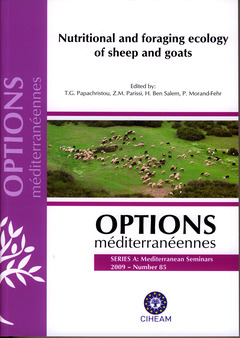Description
Nutritional and foraging ecology of sheep and goats (Options méditerranéennes series A : mediterranean seminars 2009 Number 85)
Authors: PAPACHRISTOU T.G., PARASSI Z.M., BEN SALEM H., MORAND-FEHR P.
Language: English
Subjects for Nutritional and foraging ecology of sheep and goats...:
Approximative price 76.22 €
Subject to availability at the publisher.
Add to cart
Publication date: 06-2009
490 p. · 17x24 cm · Paperback
490 p. · 17x24 cm · Paperback
Description
/li>
This publication is the outcome of the 12th Seminar of the FAO-CIHEAM Sub-Network on Sheep and Goat Nutrition "Nutritional and foraging ecology of sheep and goats" which was held in Thessaloniki (Greece) from 11-13 October 2007, and includes the invited and selected papers presented at the meeting. The seminar was jointly organized by the Food and Agriculture Organization of the United Nations (FAO), the International Centre for Advanced Mediterranean Agronomie Studies (CIHEAM) and the National Agricultural Research Foundation - Forest Research Institute (NAGREF), in collaboration with the Greek Ministry of Rural Development and Food - Directorate General for the Development and Protection of Forests and Natural Environment. The aim of this seminar was to provide a venue for specialists in livestock production, rangeland management, animal health, and animal production science to meet and discuss the current state of knowledge on the use of recent scientific advances in the small ruminants sector. The outcome was te orient the future research programmes, with the goal of developing grazing and/or feeding systems of sheep and goats that support the needs of society. Therefore, the seminar covered a avide range of topics that were allocated into three sessions and two round tables, which were: (i) Plant-animal interactions - implications for animal and landscape management, (ii) Rumen ecology and manipulation te improve small ruminant performance, (iii) Targeted feeding te improve performances of sheep and goats at different physiological stages, (iv) Strategies that use plant secondary compounds to improve the efficiency and profitability of small ruminant agriculture, and (v) Quality products of sheep and goats for human nutrition and health.
© 2024 LAVOISIER S.A.S.

